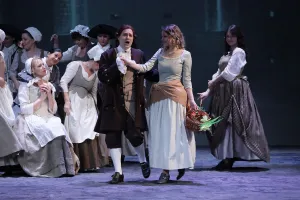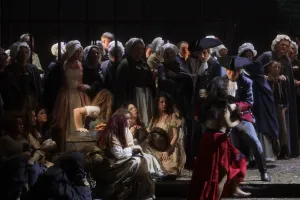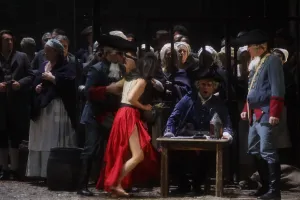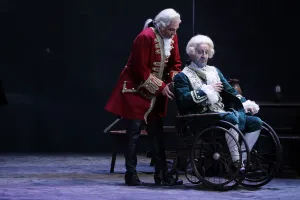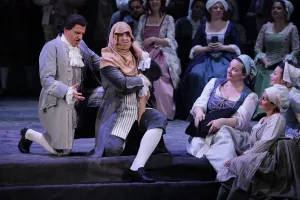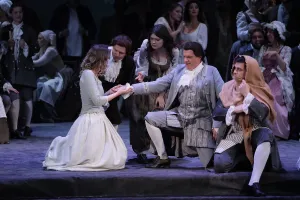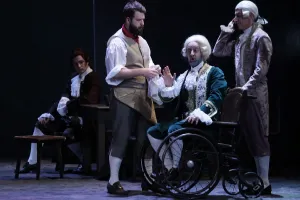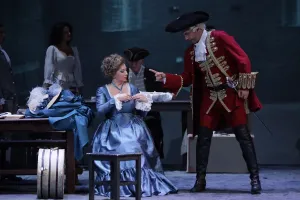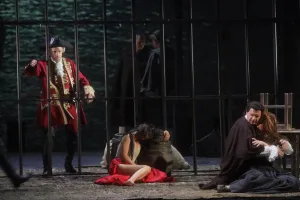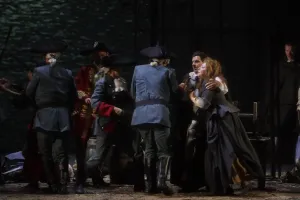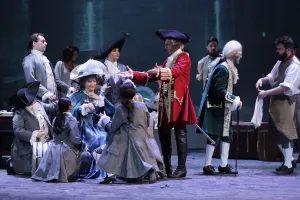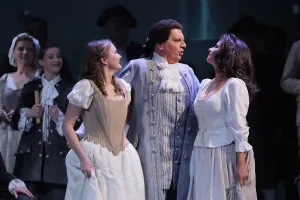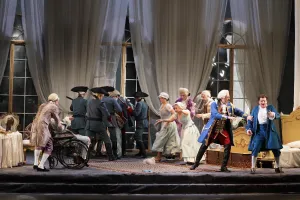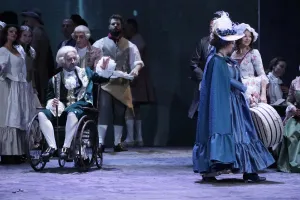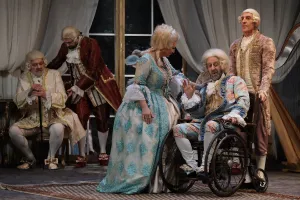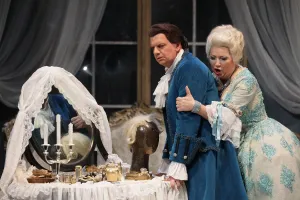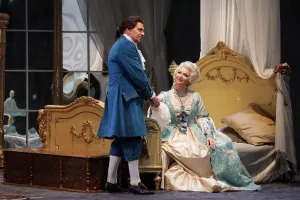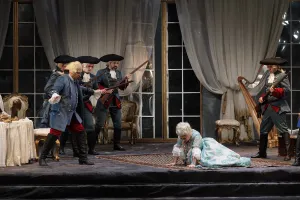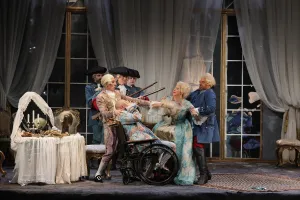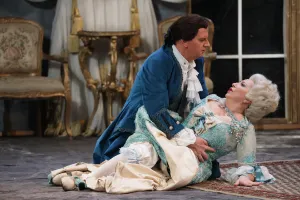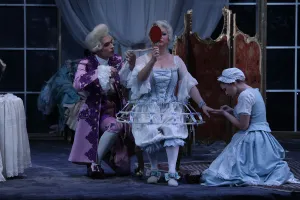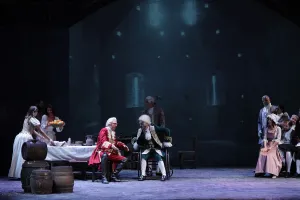Manon Lescaut
opera by Giacomo Puccini
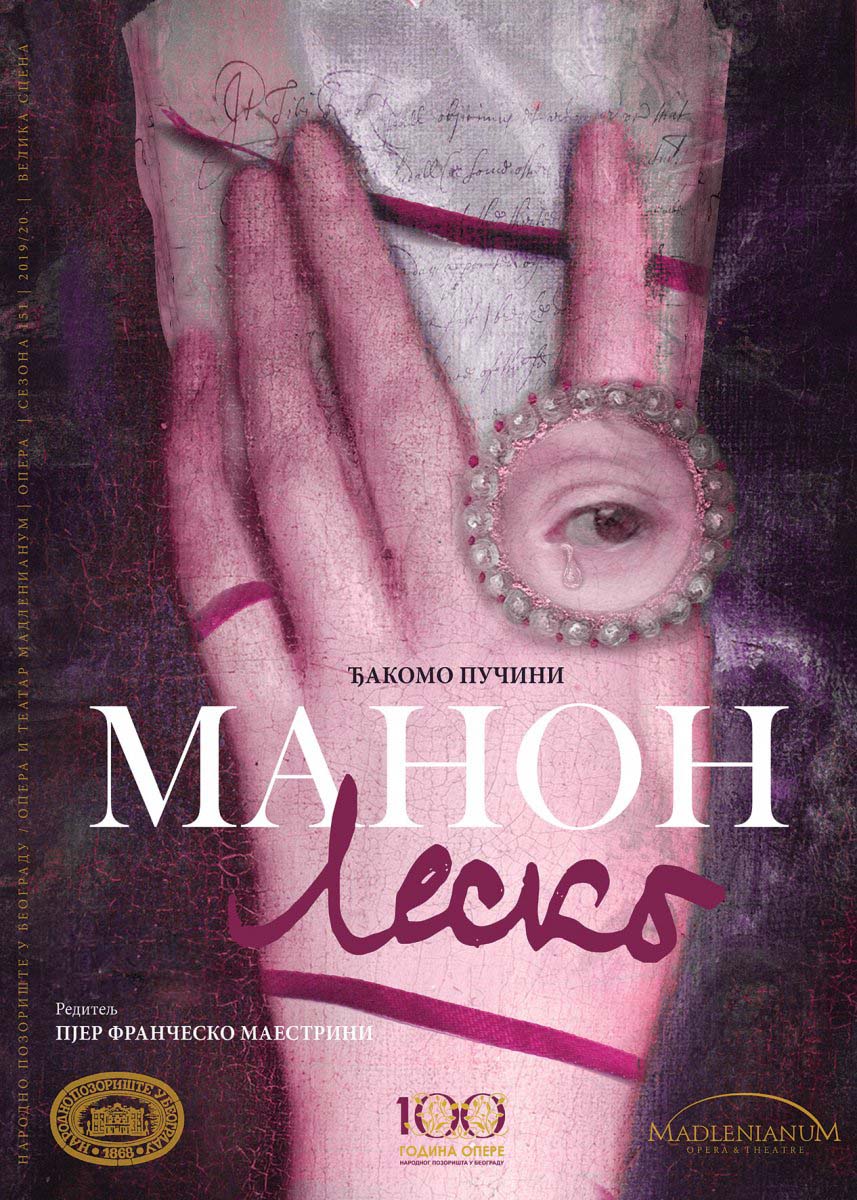
100 YEARS OF OPERA
NATIONAL THEATRE IN BELGRADE
When the Opera was established as an individual department of the National Theatre in Belgrade, at the beginning of season 1919/20, conductor Stanislav Binički was appointed its first Director. Despite difficulties regarding finding performers, the first premiere of an opera was held on 11th February 1920, it was Madam Butterfly by G. Puccini. Upon engagement of Russian artists – emigrants and our first professional singers, our Opera was constantly improving its repertoire, performances and music during the years between the two world wars. Repertory choices such as Salome by R. Strauss, Boris Godunov by M. Mussorgsky, The Four Ruffians by E. Wolf-Ferrari, The Barber of Seville by G. Rossini and other outstanding productions, had served to help advance the Opera’s position among other European opera houses that, by that time, had existed for more than two centuries. The Second World War had hindered the activities of the Opera of the National Theatre in Belgrade to a great degree. In addition, the building of the Theatre was partly destroyed in the bombardment of Belgrade, resulting in total destruction of sets, costumes and props’ fund. Nonetheless, owing to conductor O. Danon, the first post-war Director of Belgrade Opera, and owing to tremendous enthusiasm of all performers, at the time when the National Theatre did not have windows and heating, and when the décor and costumes were made even from the parachute fabric, a premiere of Eugene Onegin by P. Tchaikovsky was held on 17th February 1945. Furthermore, by the end of the season 1944/45, the productions of Pagliacci by R. Leoncavallo, La boheme, Tosca, Madam Butterfly by G. Puccini and The Bartered Bride by Smetana premiered as well. The post-war “golden period” of Belgrade Opera started in 1954 with its highly successful concert performance of Boris Godunov opera in Basel (31st March), Zurich (2nd April) and Genève (3rd April), followed by a recording of seven major operas by Russian composers from 19th century (Boris Godunov and Khovanshchina, Eugene Onegin, Queen of Spades, Prince Igor, Ivan Susanin and The Snow Maiden) for a label DECCA. Upon 15 years and 138 European performances in “Belgrade manner” (Clarendon) of 14 foreign operas and 3 operas from Yugoslav cultural heritage, the “golden period” of Belgrade Opera ended on 27th and 28th September 1969, with an extraordinary performance of Mazepa by P. Tchaikovsky on stage of Theater des Westens in Western Berlin. At the time, the international press followed all 36 tours of Belgrade Opera ensemble to renowned European operatic centres (Milan, Vienna, Rome, Paris, Berlin, Venice, Madrid…) and to most important music festivals (Florence, Edinburgh, Wiesbaden, Lausanne, Athens…), and the most eminent music critic praised the style and beauty of performances, remarkable soloist creations, sound supremacy of the choir, appeal of dances performed by the ballet ensemble and professional performance of the orchestra. According to them, the Belgrade Opera in those years managed to stand with the European opera houses which already had their developed original style of performance and expressive musical and stage appearance and provide a valuable repertory, performance and musical contribution to the world opera interpretations, which is why the period between 1954 and 1969 is rightfully seen as a performing pinnacle of Serbian operatic art and culture. Opera of the National Theatre in Belgrade is one of rare cultural institutions in Serbia that have operated continuously for a century and that have successfully established connections with cultures throughout the world. With tonight’s concert on the Sava Promenade, the principal artists of the Opera, Choir and Orchestra of the National Theatre in Belgrade would like to celebrate this important jubilee of Serbian culture and of our National Theatre and to send the message that they would continue the legacy of great artists who paved the path for our Opera, like Bahrija Nuri-Hadžić, Milorad Jovanović, Žarko Cvejić, Stanoje Janković, Melanija Bugarinović, Miroslav Čangalović, Biserka Cvejić, Radmila Bakočević, Breda Kalef, Milka Stojanović, Đurđevka Čakarević, Dušan Popović, Aleksandar Marinković, Nikola Mitić, Zvonimir Krnetić, Radmila Smiljanić, Živan Saramandić, Krešimir Baranović, Oskar Danon, Dušan Miladinović, Bogdan Babić, Borislav Pašćan and other great artists of our operatic stage.
Vladimir Jovanović
GIACOMO PUCCINI
(1858-1924)
... Italian verismo, with its dramatic scenes from ordinary people’s lives, devoid of fine psychological analysis, carelessly and superficially featured music-wise, with extreme exchanges between lyrical and brutal effects, signified reaction to Wagner’s influence, which could be partially seen in Italy in Verdi’s Otello, and especially in the oeuvre of Arrigo Boito, his Mefistofele for instance. Pure verismo was achieved only in Cavalleria rusticana by Mascagni and Pagliacci by Leoncavallo. Although their work had a lot of success and made a significant influence on European works at the end of the XIX and beginning of the XX century, Mascagni and Leoncavallo did not succeed to lift verismo style to universal significance. What they did not succeed, Puccini did, by modifying, to some extent, basic postulates of verismo aesthetics. Puccini was born on 22nd December 1858 in Lucca, a small town in Tuscany. He studied at the Milan Conservatory, mentored by Bazzini and Ponchielli, a renowned composer of La Gioconda. With lots of talent for operatic theatre, Puccini dedicated his efforts exclusively to opera compositions. After his first works (Le Villi 1884, Edgar 1889) and his first major success (Manon Lescaut 1893), he became internationally renowned with his most popular and significant works – La bohème (1898), Tosca (1900) and Madama Butterfly (1904). Then followed The Girl of the West (1912), The Swallow (1917), The Triptych (The Cloak, Sister Angelica, Gianni Schicchi 1918) and, finally, his swan song, Turandot (performed in 1926). Part of Puccini’s success lies with fortunately selected librettos. “I cannot live and not write the music,” he used to tell his biographer Fraccaroli. “And since I have no skill for symphony music, when I finish an opera, I immediately start looking for a new one. I always believe that the providence would help me find an appealing text, full of life, excitement and kindness, especially the kindness. It is painful to search for a libretto.” However, his searches for a new libretto had always been successful. Being a man of a certain theatre instinct, Puccini had a talent for stage scenes and looked for exciting drama plots and upheld the cult of grand gestures and desperate actions resulting from strong passions. Puccini formulated the secret of every theatre success, “There are three laws when theatre is concerned: stir interest, surprise and impress.” This is his aesthetic motto. Puccini paid much attention to the nerves of his audiences and influenced them, frequently using even external stimulations. His operatic style presents more or less harmonic mixture of brutality and sentimentality. The two characteristics of his style have their special origins. When brutality, naturalism, rough contrast and wide lines are concerned, Puccini’s style represents a direct continuation of verismo style. Puccini’s sentimentality comes partly from his Manon Lescaut and partly from Verdi’s Traviata. When analysed from a technical point of view, Puccini’s scores consist of mosaic musical contents, superbly and wittily instrumented and formulated into a unity by a hand of a master. Intensive orchestra emphasis of drama, surprising contrasts, great gradations, often artificial and implausible, temperamental outbursts, vocalisation of melodic lines in style of Italian tradition – were main characteristics of Puccini’s operatic style.
… even taking into account modern tendencies in opera, Puccini remains, together with Verdi, a supreme master of opera stage.
B. Dragutinović
ANTOINE-FRANÇOIS, ABBÉ PRÉVOST AND HIS NOVEL
Prolific French novelist whose fame rests entirely on one work—Manon Lescaut (1731; in full Histoire du Chevalier des Grieux et de Manon Lescaut; “Story of the Chevalier of Grieux and of Manon Lescaut”).Originally published as the final installment of a seven-volume novel, Mémoires et aventures d’un homme de qualité qui s’est retiré du monde (1728–31; “Memories and Adventures of a Man of Quality Who Has Retired from the World”) Most critics agree that the mercurial life of Abbé Prévost contributed to the creation of Manon Lescaut. After vacillating between the priesthood and the military and being satisfied with neither, he launched in the 1720’s one of the most prolific careers of the century as novelist, editor, translator, journalist, and chronicler of travel accounts. After completing four volumes of Le Philosophe anglais: Ou, Les Mémoires de Cleveland (1732-1739; The Life and Entertaining Adventures of Mr. Cleveland, Natural Son of Oliver Cromwell, 1734, 1753), Prévost began to travel between England and Holland. Apparently he was in debt in each country, possibly as the result of an uncertain relationship with a reputed Madame Lenki. In 1734, he was absolved of all clerical transgressions and received a sinecure at Evreux, which he used as a point of departure for Paris and Holland. In 1740, he traveled, again under mysterious circumstances, to Belgium and Germany. In 1746, he settled at Chaillot and continued his remarkable productivity. Church authorities rewarded his efforts by adding to his endowment. In addition to Manon Lescaut, two other works by Prévost—The Story of a Modern Greek (1740) and The Journal of an Honest Man (1745)—belong in the genre of the sentimental French novel. Two themes in these novels, which are also present in the English literature that Prévost translated by such writers as Samuel Richardson, Frances Sheridan, and John Dryden, are passionate, tragic love and redemption through suffering. Manon Lescaut was published in 1731 as the seventh volume of Mémoires et aventures d’un homme de qualité, qui s’est retiré du monde (1728-1731; Memoirs of a Man of Quality After His Retirement from the World, 1738), a rambling collection of quixotic tales and personal adventures narrated by the Marquis de Renoncour. The commonly used abridged title tends to give Manon an importance she was probably not meant to have. Renoncour introduces the Chevalier des Grieux, the protagonist of the story, but he himself does not participate in the events and he merely acts as an impartial observer of the various picaresque adventures—storms at sea, abductions, chance encounters and recognitions, and tranquil moments shattered by action and suspense. All of this is revealed from the marquis’ point of view, and it is therefore difficult to ascertain Manon’s response to her situation. Prévost combines realism—his use of the social types, names of places, and the importance of money—with pre-Romantic sentimentality. This combination allows the novel to operate on several levels. Even though Manon is at times promiscuous and des Grieux is an impetuous social deviant, they live without shame in naïve defiance of aristocratic conventions. The spirit of the novel is defined by sensuality, emphasis on living in the present, and restless frivolity. Manon and des Grieux play the following psychological roles: jilted lover, faithful husband, provider, brother and sister, mistress-mother, and abandoned child. Perhaps this explains the magnetism of Manon Lescaut to each new generation of readers. Manon was the adopted heroine of the nineteenth century; she was rhapsodized as an image of enigmatic femininity. The idealistic reader might argue that Manon’s originally pure love for des Grieux was corrupted by the harmful influence of civilization. Love is dependent on economics in the capitalist marketplace. Manon is not heartless or predatory, but she is mostly interested in maintaining a certain way of life. Perhaps the need for emotional security represents her deepest impulse. She certainly takes enormous risks to attain it. The prison scenes, the deportation of prostitutes, and the gambling dens remind the reader that a heavy penalty awaited those who failed to bargain successfully with fate. For this reason, Manon Lescaut has continued to receive praise from influential writers, and it has inspired artists worldwide.
STEFANO ROMANI
For over twenty years present as Conductor at the Teatro Sociale of Rovigo, internationally re-nowned Oboist and Conductor. He awarded in 2004 with the San Francesco Prize city of Rovigo as leading exponent of the Rodigina culture for artistic merits, he graduated at the F. Venezze con-servatory in Rovigo with honors and honors under the guidance of Professor Franco Volpe, for over thirty years present on the international scene in the most prestigious Chamber concerts and thea-ters in the world. He started very young as oboist collaborating with the most important orchestras of the national panorama among these Orchestra della Scala of Milan, Orchestra of the Teatro la Fenice of Venice, Regional Orchestra of Tuscany, Chamber Orchestra of Padua and Veneto, Orchestra Toscanini of Parma, Orchestra dei Pomeriggi Musicali of Milan, OFV, etc., with internationally renowned conductors and soloists, J. Basmet, L. Harrel, M. Tipo, M. Horne, K. Ricciarelli, R. Blake, U. Ughi, A. Specchi, S. Accardo, M. Brunello, P. Maag, M. Campori, G. Sinopoli, G. Ferro, E. Inbal, K. Penderecki, R. Boninge, B. Campanella, M. Campori, M. Arena, D. Renzetti, etc. For about twenty years he has undertaken the activity as conductor with great success, especially in the opera repertoire that has seen him protagonist in the most important and prestigious stages of the world among these: San Carlo di Napoli, National Theater of Maribor (Slovenia), Serbian National Theater of Belgrade, Skopje National Theater (Macedonia), Tbilisi National Theater (Georgia), Kazan National Theater (Russia), Bolshoiy Theater of Minsk (Belarus), Beirut (Lebanon), Haifa National Theater (Israel), Savonlinna Opera Festival (Finland), China Hangzhou Xi’an, Theater of Chendu and Xiamen, Seoul (Korea) Art Center, Manaus National Theater (Brazil), Charlotte Na-tional Theater (United States of America), Puccini Festival of Torre del Lago, Donizetti Theater of Bergamo, La Fenice Theater of Venice, Savona Theater, Sociale of Rovigo, Ente Luglio Trapanese of Trapani, Ancient Theater of Taormina, Politeama Theater of Palermo, Teatro delle Verdure of Palermo, Molfetta Theater, Viterbo Municipal Theater, Livorno Goldoni Theater, Ferrara Municipal Theater, Gorizia Municipal Theater, Treviso Municipal Theater, Vicenza Municipal Theater, Vicenza Theater, Bassano Theater, Vittorio Veneto Theater, ERT Theater of Athens, Casino Theater of San Remo, Kaukaso Philharmonic Theater (Russia) etc .. Among his next engagements a Ballet on music by W.A. Mozart and a work of Cimarosa at the San Carlo of Naples, 150th anniversary of the National Theater of Belgrade with Puccini’s Manon Lescaut, a Cavalleria Rusticana of Masca-gni directed by K. Ricciarelli at the Taranto Opera Festival, a new production of Madama Butterfly of Puccini at the National Theater of Maribor with the direction of P. Maestrini and in February in Kazan in Russia at the Jalapin Festival with two productions of Nabucco and Rigoletto. For about 8 years he was Artistic Secretary of the Filarmonia Veneta Orchestra and from 2009 to 2016 Artistic Director of the Sociale of Rovigo. Winner of the National Competition for teaching in conservatories, ranking in the first places, he sees himself as tenured professor at the F. Venezze conservatory in Rovigo.
PIER FRANCESCO MAESTRINI
Born in Firenze, starts his career in 1993 with Rossini’s Barber of Seville at the Tokyo Bunkamura Orchard Hall. Since then he directed over 150 opera productions in Italy and abroad, with a repertoire that goes from Baroque to Verismo and contemporary.In 2012 stages in Santiago (Chile) his vampire version of Mozart’s Don Giovanni in Cile, joining together two eternal myths: the libertine “Don” and Bram Stoker’s Dracula. The production has been revived the following year in São Paulo (Brazil). Still in 2012, opens the opera season in Rio de Janeiro (Brazil) with Verdi’s Rigoletto and his modern country-western version of Donizetti’s Elisir d’amore at the Slovenian National theatre in Maribor. In 2013 again in São Paulo main opera house, stages Mascagni’s Cavalleria, offering an impressively strong reference to Coppola’s Godfather movie saga. From the same year are two new productions of Verdi’s Aida (Open air Festival La Perla in Zurich, Swiss and again in Maribor SNG) and Verdi’s Othello at Pavarotti’s theatre of Modena (Italy). From 2014 are Puccini’s Turandot and La Bohème, respectively at the Teatro Lirico of Cagliari and at the Arena Foundation of Verona (Italy). In 2015 again in Verona for Verdi’s La Forza del Destino and Rossini’s Barber of Sevilla, for which title Maestrini offered a pioneering technique that saw the interaction of the singers and their alter-egos, made of animated characters in a featured Cartoon. This production has been touring the world since then in Maribor (2015), Lübeck and Kiel in 2018 (Germany), Montevideo in 2018 (Uruguay), Palermo in 2019 (Italy) and is scheduled to open at the New York City Opera next year in New York (USA). Also in 2015 stages a new production of Elisir D’Amore at the prestigious Beijing National Centre of Performing Arts (China), where Maestrini directed several titles along the years, such as Barber of Seville (2013, 2016, 2019), Donizetti’s Don Pasquale (2014 and 2017), Operetta Gala (2016) and Donizetti’s La Fille du Regiment (2018). In 2016 opens the Opera season at the Teatro Lirico di Cagliari (Italy) with the acclaimed production of Respighi’s La Campana Sommersa, opera available on DVD (Naxos editor) thatcher following year is revived with great repercussion at the Rose Theatre of the Lincoln Centre for the New York City Opera in New York (USA), and his fun Country Western version of Elisir at Teatro dell’Opera di Firenze (italy), where it’s been revived since then three more times (2017, 2018 and 2019) before being sold to Verona where it has been successfully presented last November 2019. In 2017 again in Verona with Rossini’s Viaggio a Reims, his second title blending cartoon and live action, that opened the same year Lübeck and Kiel opera seasons (Germany). Nominated Artistic Director at the Theatro Municipal of Rio de Janeiro (Brazil) for season 2018, Pier Francesco Maestrini stages there his futuristic vision of Verdi’s Un Ballo in Maschera, in coproduction with Kiel (Germany) and a new Verdi’s Rigoletto for the Teatro Lirico di Cagliari. In 2019 again in Cagliari for a new Puccini’s Tosca, stages also two more new productions of Gounod’s Faust in Maribor (Slovenia) and Giordano’s Andrea Chenier in Tours and Nice (France) His future engagements will see him again in Maribor for Puccini’s Madame Butterfly next May, in Salerno (Italy) for Cavalleria & Gianni Schicchi in April, Rigoletto at the Verdi Festival of Parma and Manon Lescaut in Palermo.
LUCA DAL ALPI
Luca Dall’Alpi was born in Faenza on 19/03/1965. His activity in the field of theatrical costume has developed in various fields, from the design phase of the sketches to the realization of the full production of tailor-made products. Luca Dall’Alpi was born in Italy. He has designed costumes for many opera productions including Lohengrin (Wagner), Die lustige Witwe (Lehar), Alceste (Gluck), Il barbiere di Siviglia (Rossini), Ernani, Aida, Luisa Miller, La traviata, Don Carlo, Rigoletto (Verdi), La Damnation de Faust (Berlioz), L’elisir d’amore (Donizetti), Don Giovanni (Mozart) and many other opera, musicals and ballet productions. He has worked at the opera houses of Rome, Santiago de Chile, Bratislava, Sao Paolo, Palermo, Verona, Parma, Maribor and others.
ALFREDO TROISI
He was born in Naples, where he studied at the Academy of Fine Arts. His debut was in the Valli Theatre in 1991, when he designed the set and costumes for Gala Concert dedicated to 30th anniversary of Luciano Pavarotti’s career. He has worked on numerous installations for prestigious national and international theatres: production of Macbeth in Monte Carlo on occasion of 700th anniversary of Grimaldi family, Faust in Marseilles, Macbeth in Tokyo, Turandot and Rigoletto in Rio de Janeiro, Manon Lescaut in Seoul, La Traviata and Tosca directed by Maestro Oren in Tel Aviv, etc. In Italy, he has cooperated with the Rome Opera House, Massimo Theatre in Palermo, Theatre San Carlo in Naples…
SYNOPSIS
ACT I A square in Amiens. Edmondo, a songwriter, and his student companions flirt with some factory girls. His friend, des Grieux, also a student, stays apart from them. A coach arrives, bringing Geronte, a tax collector, and Lescaut, a soldier, who is accompanying his younger sister, Manon. Des Grieux falls in love with her at first sight, finds out that her father is sending her to a convent, and makes plans to prevent this from happening. But Geronte, with Lescaut’s connivance, intends to abduct Manon. Edmondo overhears his plans and warns des Grieux, who escapes with Manon to Paris. Lescaut consoles Geronte by telling him that Manon will not stay long with a student and that he will bring her back to him.
ACT II A house in Paris. Manon has left des Grieux and is living a life of luxury with Geronte. She’s bored and her brother promises to arrange for des Grieux to visit her. Some singers serenade Manon with a madrigal written by Geronte. Then she dances and sings for him and his friends. When they leave she tells Geronte that she will follow shortly, but des Grieux appears and Manon starts to seduce him. Geronte interrupts their lovemaking, chillingly threatens the two of them, and leaves, telling them he will return soon. Lescaut runs in, warning the lovers that Geronte is going to get Manon arrested and that she must escape. She delays, trying to collect her jewelry, but is arrested before she can escape.
ACT III Outside a prison in Le Havre by the harbor. Dawn. Des Grieux waits outside the prison where Manon is held. Lescaut bribes a sentry to allow his sister to spend time with des Grieux, while he organizes a group to enable her escape. The effort fails, a shot is fired. Townspeople run in. The soldiers restore order and the captain of the ship processes Manon and the other prisoners—mostly prostitutes—before they are deported. In desperation des Grieux grabs Lecsaut’s weapon and threatens the captain, who faces him down. Des Grieux pleads with the captain to be allowed to sail with them as one of the crew.
ACT IV A desert. Des Grieux and Manon are on the run. They are at the end of their strength, collapsing from thirst and exhaustion. Des Grieux leaves Manon, searching for water. When he returns, he finds her dying. In her last breath she says she loves him.
Premiere performance
Premiere 26. February 2020
Main stage
Libretto: Domenico Oliva, Marco Praga, Giuseppe Giacosa & Luigi Illica
Opera in four acts.
Conductor Stefano Romani, k. g, Đorđe Pavlović
Director Pjer Frančesko Maestrini, k. g.
Costume Designer Luka Dal Alpi, k. g.
Set Designer Alfredo Troizi, k. g.
Premiere cast:
Manon Lescaut Jasmina Trumbetaš Petrović, Sanja Kerkez, Ana Rupčić
Lescaut, her brother and guardian, a sergeant in the King’s guard Nebojša Babić k.g, Vuk Zekić, Vladimir Andrić
Chevalier Des Grieux Nikola Kitanovski k.g, Janko Sinadinović, Dejan Maksimović
Geronte di Ravoir, Treasurer General Dragoljub Bajić, Mihailo Šljivić, Aleksandar Stamatović
Innkeeper Milan Obradović, Vuk Radonjić
Edmondo, a student Siniša Radin, Darko Đorđević, Milan Panić
Musician Nataša Rašić, Ivana Živadinović
Dance Master Siniša Radin, Milan Panić
Lamplighter Siniša Radin, Mihailo Otašević
Sergeant of the Royal Archers Mihailo Šljivić, Milan Obradović
Naval Captain Milan Obradović, Mihailo Šljivić
Hairdresser Luka Pređa
CHOIR, ORCHESTRA AND MEMBERS OF THE „BORISLAV POPOVIĆ“ OPERA STUDIO
Assistant Director Ivana Dragutinović Maričić
Assistant Director Ana Grigorović
Concertmistress Edit Makedonska/Vesna Janssens
Chorus Master Đorđe Stanković
Producers Maša Milanović Minić, Natalija Ignjić Živanović
Translation of libretto for subtitles Gavrilo Rabrenović
Music Reherseal Associates Srđan Jaraković, Nevena Živković, Gleb Gorbunov
Stage Manager Branislava Pljaskić/Ana Milićević
Prompter Silvija Pec/Kristina Jocić
Light operater Miodrag Milivojević
Make-up Marko Dukić
Stage Crew Chief Zoran Mirić
Sound Operater Tihomir Savić
Costume Designer Assistants Olga Mrđenović and Aleksandra Pecić
Set Designer Assistant Jasna Saramandić
Video Petar Antonović
Extras led by Zorana Trifunovića
SETS AND COSTUMES WERE MANUFACTURED IN THE NATIONAL THEATRE WORKSHOPS

